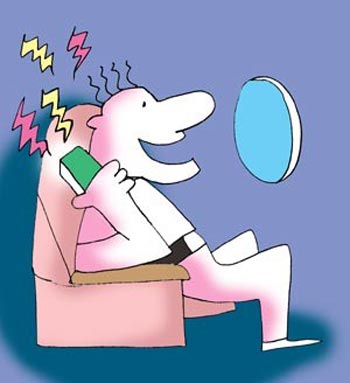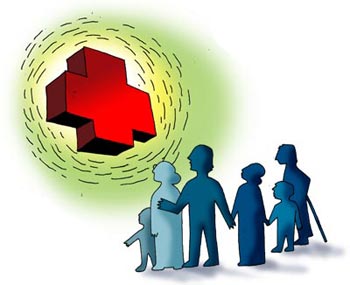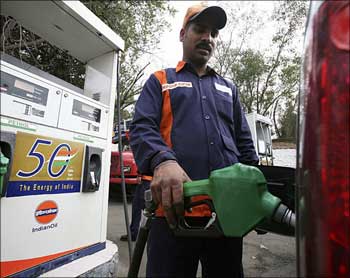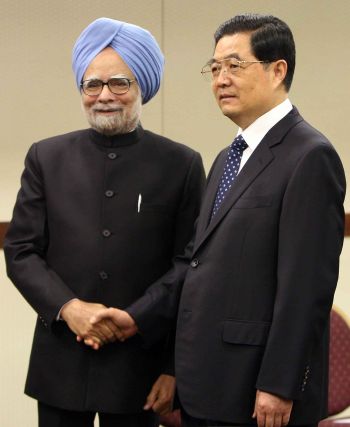
You will soon be able to use your mobile phone after your aircraft has landed and is taxiing towards the parking bay.
This will be made possible only after a new rule, aimed at relaxing the present procedures a bit, is adopted by the government.
Currently, mobile phones can be used only when the doors of an aircraft are open, either before take-off or after landing and parking.
Under this draft rule, a pilot can permit the use of mobile phones inside the aircraft after it has "landed and cleared the active runway", that is before it has parked and the doors have been opened.
But the new rule makes it clear that a pilot would not permit the use of cellphones if "the landing takes place in low visibility conditions".
The rule also makes it clear that "an aircraft shall be deemed to be in flight when all its external doors are closed following embarkation until the moment when any such door is opened for disembarkation".
The government has sought objections or suggestions from the public on this draft rule by the middle of August.
Once the rule is adopted, it would form part of Aircraft Rules of 1937, which govern the entire gamut of civil aviation procedures in the country.
NEXT: Cashless treatment: Insurers, hospitals to sort out issue

State-owned insurance companies and private hospitals would be meeting on Friday to sort out the problem concerning suspension of cashless mediclaim facilities at select hospitals.
Besides representatives of six hospitals, the meeting, which is an initiative of industry chamber Confederation of Indian Industries, will be attended by officials of four public sector general insurance companies.
From July 1, the public sector insurance companies had taken off about 150 hospitals from the list of Preferred Provider Network (PPN) that offer cashless hospitalization service to policy holders under the mediclaim scheme.
The four insurance companies -- New India Assurance, United India Insurance, National Insurance and Oriental Insurance -- had stopped the cashless service because of alleged over-billing by some private hospitals.
At a meeting earlier this month, the four general insurance companies had agreed to restore the facility on case-to-case basis.
Friday's meeting would also discuss the restoration possibility of the cashless treatment facility.
Besides the insurance companies, the meeting would be attended by representatives of Fortis, Max Healthcare, Apollo Hospitals, Medicity, Johnson and Johnson Medical India and Hinduja National Hospital.
NEXT: Strike: Air India, Jet suffered loss of Rs 127 crore

Air India and Jet Airways suffered a loss of Rs 127 crore (Rs 1.27 billion) due to the three strikes by their employees since last year, Civil Aviation Minister Praful Patel informed the Lok Sabha on Thursday.
Ailing national carrier, Air India has suffered a loss of Rs 77 crore (Rs 770 million) in the strikes by executive pilots last year and by employees this May, Patel said in a written reply.
In order to prevent any strike, the Air India board has constituted a human resource sub-committee to consider various issues and grievances of its employees.
In September last, Air India's executive pilots had stopped the work by reporting sick en-mass after the airline management proposed a cut in their flying allowance. The five-day strike started on September 26.
Again, in May this year, employees associated with two of the unions, All India Aircraft Engineer's Association (AIAEA) and Air Corporation Employee's Union (ACEU), went on flash strike in protest of alleged gag order by the airline management restricting union office-bearers not to go to media and other issues.
Also, in September last year, Jet Airways pilots simulated strike by reporting sick for five days.
To a separate question, Patel said that prior to merger of erstwhile Indian Airlines and Air India, both the airlines suffered a loss of Rs 240.29 crore (Rs 2.403 billion) and Rs 447.43 crore (Rs 4.474 billion), respectively.
But after the merger, Air India suffered a loss of Rs 2,226.16 crore (Rs 22.262 billion) and Rs 5,548 crore (Rs 55.48 billion) in 2007-08 and 2008-09, respectively.
"The national carrier is supposed to post a loss of Rs 5,400 crore (Rs 54 billion) in last fiscal (2009-10)," Patel said, adding losses were incurred due to prevalent economic recession, higher fuel prices, low yields and load factors.
The government has proposed to infuse Rs 2,000 crore (Rs 20 billion), in five equal instalments, to help the ailing national carrier.
"An amount of Rs 800 crore (Rs 8 billion) has been released in February and March and provision Rs 1,200 crore (Rs 12 billion) made in the current financial year. The amount would be released after considering the company's achievement of their turnaround plan," Patel said.
NEXT: Hike in fuel prices minimal: Deora

"No government can survive if they don't know the feeling of voters. We want people and Opposition parties to understand the compulsions under which we took this decision and the minimal impact it will have on people," he said.
Describing claims made by critics of the June 25 decision as "exaggeration", he said the Rs 35 increase in the price of LPG cylinders translated into an additional burden of less than a rupee per day, considering that a 14.2-kg cylinder of domestic gas lasts 30-35 days.
The Rs 3 a litre hike in kerosene translated into an additional burden of 50 paisa per day for a household using 5 litres a month of PDS kerosene.
In a tongue-in-cheek comment, Deora said he met a friend from one of the Left parties this morning and explained the compulsions that led to the price hike.
"It is very difficult to show reason to Communists. God knows if he understood what I said," he said speaking at the signing of contracts for coal-bed methane blocks awarded in the fourth round late last year.
The hike had become necessary as the difference between retail selling price and cost of production had become unmanageable.
"We have kept the burden on the poor man the minimal. The talk of the hike breaking the back of the poor and common man is nothing but exaggeration," he said.
The Congress-led UPA government did not increase kerosene prices for the past six years, despite the price of crude oil (the raw material for making petrol, diesel, domestic LPG and kerosene) more than doubling from $36 a barrel in May, 2004, to $78.
"We raised kerosene rates by Rs 3 per litre against the required increase of Rs 18.07 per litre," Deora said, adding that LPG continues to be under-priced by Rs 226.90 per cylinder.
NEXT: Huawei enters India mobile phone market

Chinese telecom equipment maker Huawei Technologies announced its entry into the Indian mobile handset market with the launch of 20 new handsets.
Till now, Huawei was selling handsets bundled with services offered by telecom operators like Tata Teleservices and BSNL.
"The Indian telecom industry is growing at the rate of 20 million subscribers a month. Our entry into the open market will help us tap more growth opportunities in India," Huawei Device chief marketing officer Victor Xu said.
The phones have been launched under two series Hangout and Android -- which are based on Qualcomm's chipset solutions.
The handsets, priced at Rs 2,000 onwards, will be available from August.
Asked about the new government directive asking telecom equipment-makers to deposit source codes and detailed designs for all their products and services in an escrow account, the company said it has received the notification.
"We have received the notification and are going through it and after going through it, we should be able to comment on it," Huawei Telecommunications (India) executive director A Sethu Raman said.
NEXT: Indo-China may touch $60 billion

The Indo-Chinese trade is on course to touch the record $60-billion target set for this year as bilateral trade volumes crossed $30.37 billion in the first half of this year with Indian exports registering a healthy 81 per cent growth so far.
According to the January-June trade data released by the Chinese customs, bilateral trade volume touched $30.37 billion, posting a 54 percent jump in H1 compared over the same period last year. Last year trade declined to about $44 billion due to the global economic downturn.
In 2008
the bilateral trade touched a record $52 billion, prompting both sides to set an ambitious $60 billion target for 2010.
Indian exports to China touched $11.9 billion, a rise of 81 per cent. Commodities continue to be the main stay of Indian exports with iron ore topping the list with $7.7 billion as an energy-hungry China stepped up ore imports.
Indian ore exports meet about 17 per cent of Chinese needs.
India's cotton, yarn and fabric exports to the worlds' fastest growing large economy together touched $1.1 billion.
Exports of copper, copper articles, organic chemicals and precious stones netted $350 million each.
As expected, China had the lion's share with $18.4 billion exports to India, posting a 42 per cent increase compared to last year. Machinery and electrical machinery topped the list for China with $4.5 billion and $4.3 billion, respectively, backed by $1.9 billion of organic chemicals, and $1.4 billion of iron and steel products.
Surprisingly Chinese telecom equipment, too, has done well in the first half despite the reported ban on it in New Delhi as Chinese telecom companies exported machinery worth about $1.65 billion dollars to India compared to $1.9 billion in the same period last year.
Commenting on the trade figures, Indian Ambassador S Jaishankar told PTI here that "I am happy with the growth that we are likely to meet the trade target of $60 billion. But I still feel looking at our figures that market access issues have not been addressed sufficiently. We are doing 17 trade promotions this year. We will keep up efforts to obtain better market access."
During the past few months, Jaishankar has launched an aggressive campaign to push Indian exports taking advantage of improvement of bilateral ties. As per the new strategy, Indian officials have identified IT, drugs,agro goods and engineering goods as the main items that could make a dent in China.
India's concerns over trade deficit, which touched $16 billion, topped the agenda during the recent high level visits by President Pratibha Patil and National Security Advisor Shivshankar Menon and External Affairs Minister SM Krishna.
China has been promising to improve trade access to India n goods especially products like IT and pharmaceuticals, they hope would make a steady headway in China in the later half of this year.